Difference between revisions of "2.03 Invalid Permit"
(→Staff Instructions) |
(→Staff Instructions) |
||
| Line 80: | Line 80: | ||
Oh...and take this disk with you. It contains software for remote access to the time machine's View-O-Scope...if we ever get that working again. [sigh] In fact, here are two identical disks in case you want to run it on two computers. | Oh...and take this disk with you. It contains software for remote access to the time machine's View-O-Scope...if we ever get that working again. [sigh] In fact, here are two identical disks in case you want to run it on two computers. | ||
}} | }} | ||
| + | |||
| + | Have a GC member with a computer enter team's start time in the online tracking database. | ||
'''Site Close Down''': Once the last team leaves the set can be converted back to Trenchwood Institute. | '''Site Close Down''': Once the last team leaves the set can be converted back to Trenchwood Institute. | ||
Revision as of 18:04, 17 March 2012
Contents
- 1 Status
- 2 Location
- 3 Type
- 4 Plot Setup
- 5 Props
- 6 Plot Point to Convey
- 7 Short Description
- 8 Open Time Period
- 9 Staff Instructions
- 10 Detailed Description
- 11 How To Give To Teams
- 12 Puzzle Answer
- 13 Puzzle Solution
- 14 Budget
- 15 Credits
- 16 Manager
- 17 Hints
- 18 Response to Correct Answer
- 19 To Do
- 20 Other Notes
Status
::REVISE::
Location
(See Sign In Act II)
Type
Mandatory Puzzle
Plot Setup
- All evidence of Trenchwood Institute and its timeline has mysteriously disappeared.
- Peach Frontier Laboratories has taken its place
- Iconoclast scientist Prof. Chronos has attempted to demonstrate her time machine before an audience of VIPs.
- But it malfunctioned due to faulty key components--quantum chronomentometers.
- The malfunction is causing the Professor to bounce around randomly in time from era to era, facing untold dangers!
Props
- 16 collections of permit applications
- Lab coat (should already have)
- Peach Frontier name badge and lanyard (should already have)
- Government official outfit? for the inspector?
- 32 or 34 View-O-Scope Computer Remote Access Program diskettes
- 16 or 17 contact information sheets for Peach Frontier Laboratories
Plot Point to Convey
Prof. Chronos is willing to be a bit sneaky if needed.
Short Description
A government regulator threatens to shut down the lab unless a seemingly impossible series of forms are filled out correctly.
Open Time Period
Sunday, midnight - till all teams (16 in Game 1, 17 in Game 2) have completed (estimated 1:40 AM)
Staff Instructions
Your Role: Lab Assistant at Peach Frontier Laboratories.
What To Wear: lab coats + Peach Frontier Laboratories name badges
What Your Character Knows: everything in "Plot Setup"
Puzzles At This Site: Several, but this sheet only covers Core Dump 2.
Where To Get Materials: GC HQ
Setup Instructions: n/a
Handout Instructions: Lab assistant says words to the effect of,
- You’ve got to help! See that guy over there? He’s the new government inspector and he says he’s going to shut us down because we don’t have a valid operating permit. We can’t shut down—we need to keep operating so we can save Prof. Chronos!
- I thought we took care of this permit long ago. First I tried to fill out the eight required forms myself…but you know how impossible government forms are to fill out.
- So Prof. Chronos took the forms from me, filled them out, and met with the old inspector. She assured me everything was all taken care of…and if there was ever any problem to just refer to the forms she filed.
- Now this new guy shows up…says he doesn’t know anything about what the old guy did...and that our forms aren’t valid! I looked at them and he’s right: the Professor filled out the top part!
- Will you please look at the forms and fix this mess? You can submit forms to the inspector for his approval.
Hand them the collection of permit application forms (usher them outside?) and then have a GC member with computer enter team's start time in the tracking database.
Answers: There is no "answer" to this puzzle. The team just has to roleplay bribing the staffer playing the role of the regulator to that staffer's satisfaction.
After bribing the regulator, the team speaks with a lab assistant who leads them into Chronomentometer 1 with words to the effect of
Phew! Now that you've got that taken care of, it turns out that Doctor When could use your help with the chronomentometers. We blew four of the modules and so we need four new designs. Unfortunately his expertise is mainly in the theoretical realm. Only Prof. Chronos was truly driven to implement a working device.
But luckily there are nearby experts in applied chronodynamics who just may be able to help you. Please go to the Clocksmith Technologies at 806 El Camino Real, San Carlos. There you will be able to get the initial specifications for the new modules, which you can use to design new ones.
Please upload your four designs on our web site once you're done. The address is peachfrontier.com/cmm/. Here--I've written it all down for you. After you enter the design please email the lab to let us know you're done. If you have any trouble with your design call (650) 395-TIME and one of the lab assistants may be able to help.
Oh...and take this disk with you. It contains software for remote access to the time machine's View-O-Scope...if we ever get that working again. [sigh] In fact, here are two identical disks in case you want to run it on two computers.
Have a GC member with a computer enter team's start time in the online tracking database.
Site Close Down: Once the last team leaves the set can be converted back to Trenchwood Institute.
Other Instructions:
- Stay in character.
- Except ... if a team says "time out," break character and help them.
Detailed Description
How To Give To Teams
Done in person--see Staff Instructions
Puzzle Answer
The puzzle solves to the phrase:
The 8 "forms" are impossible; but-fortunately-bribery will work.
For teams to successfully solve the puzzle, they must roleplay bribing the GC member playing "Dickless," the government regulator.
Puzzle Solution
The puzzle has a BIG red herring -- it looks like a puzzle that is about solving WPC-style logical constraint-satisfaction puzzles, but it is actually a Game-style decoding puzzle.
Incidentally, each form appears to come from one of the government teams that are playing. It will be ironic that a team can't solve its own form.
A very astute team that is paying attention to the story (not that we expect any teams to get this immediately, but we can hope) will realize Catherine had absolutely no control over the contents of the forms, and only pay attention to the bit that Catherine did have control over, which is the section at the top where she filled in the name and address.
She has sneakily hidden an important message in how she writes her letters and numerals -- read across the forms, the variants spell out a message in 8-bit ASCII. The forms are actually given in order, but they should be sorted by their form number. The form number can be decoded to make a puzzle name, but that is part of the red herring.
| Bit value | Form number | Decodes to |
| 128 | B12020125-S8916 | BATTLE-SHIP |
| 64 | F212015-S89119 | FUTO-SHIKI |
| 32 | H11989 | HASHI |
| 16 | KA11211815 | KAKURO |
| 8 | KE14-K514 | KEN-KEN |
| 4 | M9145-S235516518 | MINE-SWEEPER |
| 2 | N151415-G18113 | NONO-GRAM |
| 1 | S129208518-L91411 | SLITHER-LINK |
As 8-bit ASCII always has the first bit as zero for standard messages, the first form indicates a value of "0" for all bits. The decoding mixes uppercase, lowercase, and even punctuation marks and one numeral.
| Chr | Decimal | 128 | 64 | 32 | 16 | 8 | 4 | 2 | 1 | What the variant looks like | |
| T | 84 | 0 | 1 | 0 | 1 | 0 | 1 | 0 | 0 | P | More cursive, top-left-corner curves out |
| h | 104 | 0 | 1 | 1 | 0 | 1 | 0 | 0 | 0 | e | has straight horizontal bar |
| e | 101 | 0 | 1 | 1 | 0 | 0 | 1 | 0 | 1 | a | two-storied instead of one |
| 32 | 0 | 0 | 1 | 0 | 0 | 0 | 0 | 0 | c | curve lifts higher | |
| 8 | 56 | 0 | 0 | 1 | 1 | 1 | 0 | 0 | 0 | h | more cursive, has lifting tail |
| 32 | 0 | 0 | 1 | 0 | 0 | 0 | 0 | 0 | F | top bar sticks out to the left | |
| " | 34 | 0 | 0 | 1 | 0 | 0 | 0 | 1 | 0 | r | curve lifts higher |
| f | 102 | 0 | 1 | 1 | 0 | 0 | 1 | 1 | 0 | o | loop starts at bottom instead of top |
| o | 111 | 0 | 1 | 1 | 0 | 1 | 1 | 1 | 1 | n | cursive, with hook at end |
| r | 114 | 0 | 1 | 1 | 1 | 0 | 0 | 1 | 0 | t | vertical stroke curves towards right |
| m | 109 | 0 | 1 | 1 | 0 | 1 | 1 | 0 | 1 | i | dot is a diagonal stroke |
| s | 115 | 0 | 1 | 1 | 1 | 0 | 0 | 1 | 1 | e | has straight horizontal bar |
| " | 34 | 0 | 0 | 1 | 0 | 0 | 0 | 1 | 0 | r | curve lifts higher |
| 32 | 0 | 0 | 1 | 0 | 0 | 0 | 0 | 0 | C | curve lifts higher | |
| a | 97 | 0 | 1 | 1 | 0 | 0 | 0 | 0 | 1 | a | two-storied instead of one |
| r | 114 | 0 | 1 | 1 | 1 | 0 | 0 | 1 | 0 | t | vertical stroke curves towards right |
| e | 101 | 0 | 1 | 1 | 0 | 0 | 1 | 0 | 1 | h | more cursive, has lifting tail |
| 32 | 0 | 0 | 1 | 0 | 0 | 0 | 0 | 0 | e | has straight horizontal bar | |
| i | 105 | 0 | 1 | 1 | 0 | 1 | 0 | 0 | 1 | r | curve lifts higher |
| m | 109 | 0 | 1 | 1 | 0 | 1 | 1 | 0 | 1 | i | dot is a diagonal stroke |
| p | 112 | 0 | 1 | 1 | 1 | 0 | 0 | 0 | 0 | n | cursive, with hook at end |
| o | 111 | 0 | 1 | 1 | 0 | 1 | 1 | 1 | 1 | e | has straight horizontal bar |
| s | 115 | 0 | 1 | 1 | 1 | 0 | 0 | 1 | 1 | C | curve lifts higher |
| s | 115 | 0 | 1 | 1 | 1 | 0 | 0 | 1 | 1 | h | more cursive, has lifting tail |
| i | 105 | 0 | 1 | 1 | 0 | 1 | 0 | 0 | 1 | r | curve lifts higher |
| b | 98 | 0 | 1 | 1 | 0 | 0 | 0 | 1 | 0 | o | loop starts at bottom instead of top |
| l | 108 | 0 | 1 | 1 | 0 | 1 | 1 | 0 | 0 | n | cursive, with hook at end |
| e | 101 | 0 | 1 | 1 | 0 | 0 | 1 | 0 | 1 | o | loop starts at bottom instead of top |
| ; | 59 | 0 | 0 | 1 | 1 | 1 | 0 | 1 | 1 | s | angular, like a backwards "z" |
| 32 | 0 | 0 | 1 | 0 | 0 | 0 | 0 | 0 | 2 | has loop in lower-left | |
| b | 98 | 0 | 1 | 1 | 0 | 0 | 0 | 1 | 0 | 3 | top half "bigger" than the bottom |
| u | 117 | 0 | 1 | 1 | 1 | 0 | 1 | 0 | 1 | 2 | has loop in lower-left |
| t | 116 | 0 | 1 | 1 | 1 | 0 | 1 | 0 | 0 | 0 | has a slash and loop starts at bottom |
| - | 45 | 0 | 0 | 1 | 0 | 1 | 1 | 0 | 1 | N | diagonal meets the right stroke in middle |
| f | 102 | 0 | 1 | 1 | 0 | 0 | 1 | 1 | 0 | e | has straight horizontal bar |
| o | 111 | 0 | 1 | 1 | 0 | 1 | 1 | 1 | 1 | w | is rounded |
| r | 114 | 0 | 1 | 1 | 1 | 0 | 0 | 1 | 0 | p | has loop |
| t | 116 | 0 | 1 | 1 | 1 | 0 | 1 | 0 | 0 | o | loop starts at bottom instead of top |
| u | 117 | 0 | 1 | 1 | 1 | 0 | 1 | 0 | 1 | r | curve lifts higher |
| n | 110 | 0 | 1 | 1 | 0 | 1 | 1 | 1 | 0 | t | vertical stroke curves towards right |
| a | 97 | 0 | 1 | 1 | 0 | 0 | 0 | 0 | 1 | S | top half "bigger" than the bottom |
| t | 116 | 0 | 1 | 1 | 1 | 0 | 1 | 0 | 0 | t | vertical stroke curves towards right |
| e | 101 | 0 | 1 | 1 | 0 | 0 | 1 | 0 | 1 | r | curve lifts higher |
| l | 108 | 0 | 1 | 1 | 0 | 1 | 1 | 0 | 0 | e | has straight horizontal bar |
| y | 121 | 0 | 1 | 1 | 1 | 1 | 0 | 0 | 1 | e | has straight horizontal bar |
| - | 45 | 0 | 0 | 1 | 0 | 1 | 1 | 0 | 1 | t | vertical stroke curves towards right |
| b | 98 | 0 | 1 | 1 | 0 | 0 | 0 | 1 | 0 | S | top half "bigger" than the bottom |
| r | 114 | 0 | 1 | 1 | 1 | 0 | 0 | 1 | 0 | a | two-storied instead of one |
| i | 105 | 0 | 1 | 1 | 0 | 1 | 0 | 0 | 1 | n | cursive, with hook at end |
| b | 98 | 0 | 1 | 1 | 0 | 0 | 0 | 1 | 0 | M | middle pointer doesn't go down all the way |
| e | 101 | 0 | 1 | 1 | 0 | 0 | 1 | 0 | 1 | a | two-storied instead of one |
| r | 114 | 0 | 1 | 1 | 1 | 0 | 0 | 1 | 0 | t | vertical stroke curves towards right |
| y | 121 | 0 | 1 | 1 | 1 | 1 | 0 | 0 | 1 | e | has straight horizontal bar |
| 32 | 0 | 0 | 1 | 0 | 0 | 0 | 0 | 0 | o | loop starts at bottom instead of top | |
| w | 119 | 0 | 1 | 1 | 1 | 0 | 1 | 1 | 1 | C | curve lifts higher |
| i | 105 | 0 | 1 | 1 | 0 | 1 | 0 | 0 | 1 | a | two-storied instead of one |
| l | 108 | 0 | 1 | 1 | 0 | 1 | 1 | 0 | 0 | l | vertical stroke curves towards right |
| l | 108 | 0 | 1 | 1 | 0 | 1 | 1 | 0 | 0 | i | dot is a diagonal stroke |
| 32 | 0 | 0 | 1 | 0 | 0 | 0 | 0 | 0 | f | tail descends and curves towards left | |
| w | 119 | 0 | 1 | 1 | 1 | 0 | 1 | 1 | 1 | o | loop starts at bottom instead of top |
| o | 111 | 0 | 1 | 1 | 0 | 1 | 1 | 1 | 1 | r | curve lifts higher |
| r | 114 | 0 | 1 | 1 | 1 | 0 | 0 | 1 | 0 | n | cursive, with hook at end |
| k | 107 | 0 | 1 | 1 | 0 | 1 | 0 | 1 | 1 | i | dot is a diagonal stroke |
| . | 46 | 0 | 0 | 1 | 0 | 1 | 1 | 1 | 0 | a | two-storied instead of one |
The hidden message is:
The 8 "forms" are impossible; but-fortunately-bribery will work.
This tells the teams that they must bribe the official.
Making Progress on the Decoy Puzzle
Each form describes a "classic" logic constraint-satisfaction puzzle.
The form numbers decode using a simple code that is hinted at with an example in the second form -- A is 1, B is 2, and so on, with all the numbers concatenated together. The code decodes to the name of the puzzle type, which will help confirm the teams that they are indeed solving a puzzle of that type and giving them a second copy of the rules that may be easier to read than the "government form" version.
Each puzzle is intended so that a solver can make significant progress before they should figure out that the puzzle is possible. Here we describe some of the progress that can be made.
WHOMP - Battleship
A solver should be able to quickly place a four, a three, and a one in the left side of the grid. They will then be at this point:

From here, they will have to do some bifurcation to continue. One good way to get started is to pay attention to the bottom two rows. The bottom row can only get one more "X", and the next-to-bottom row can only get one filled-in cell. So, which cell in the next-to-bottom row is filled? It can't be C or E because that would make more than one "X" in the bottom row (because of diagonals). It can't be D because that would make two "X"s right underneath it (because of column restrictions). It can't be B because that kills too many cells in the fifth column. That leaves just A and F as possibilities.
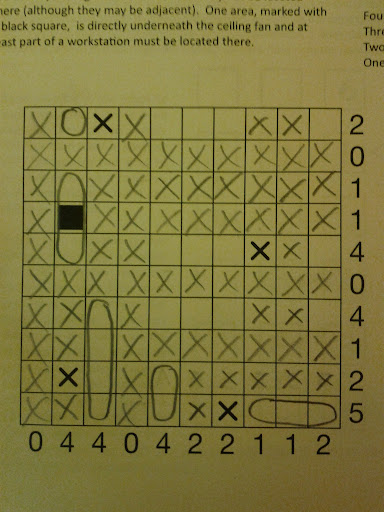
Trying case A has problems with the two "4" rows -- at least one of them needs an "X" in the right-most column (since that one's only a 2), and that creates a third 1x3 block, which isn't allowed. Case F also has problems with the two "4" rows -- at most one of the rows can fill the 6th column, which means that the other one must have three 1x1 blocks, which is too many since we already have two of them.
REDTaPE - Futoshiki
There are two chains here that interact with the 3. Putting some of those constraints in should get to this stage:
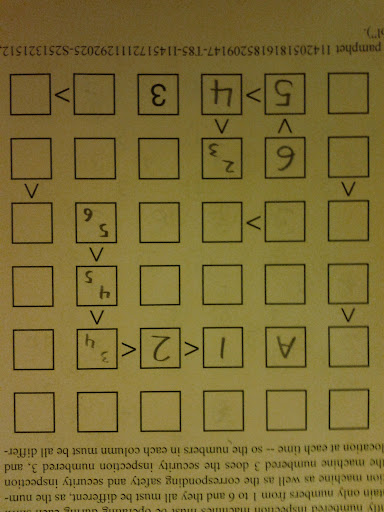
The next insight is to realize that cell A can only be 3 or 4. This means that the other two cells in the row must be 5 or 6, and that places all the 6s and then uniquely determines the top chain. Looking at the fourth row then helps determine the third column.
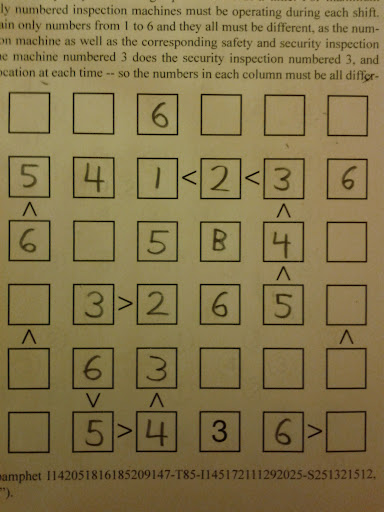
Cell B can only contain a 1, which lets us put more numbers in:
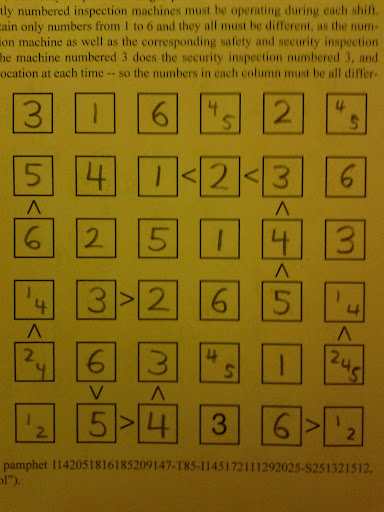
From here we're stuck. Column 1 makes row 5 need a 4, then we have problems with the other cells in row 5.
Laotian Coast Guard - Hashi
Here's a basic guide on solving Hashi puzzles: [[1]]
Using those techniques, this is as far as you can get with this puzzle:
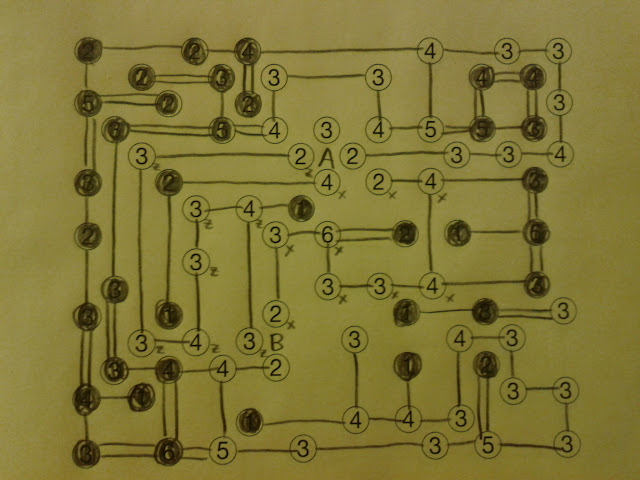
This is the main sticking point of this puzzle. What you can then notice (not that it's easy) is that the areas with the cells marked "X" need to escape using an even number of bridges at A and B, and same goes for the cells marked "Z". That means that it has to be 2 vertical bridges at A and two horizontal bridges at B, and this leads to a parity issue later on, for example:
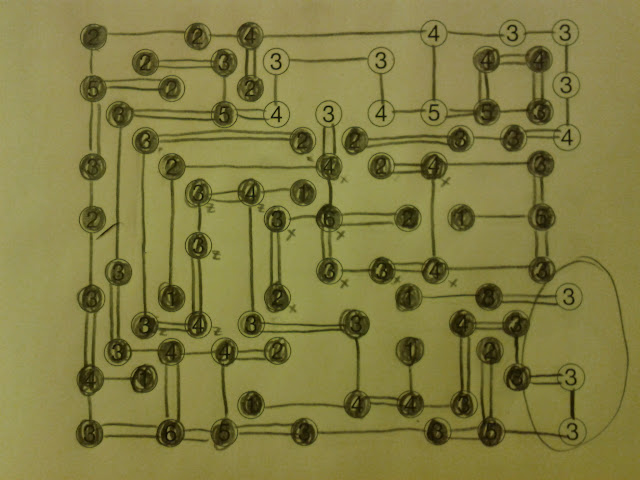
One could get here by other means, such as starting at the parity issue in the lower-right and discovering that they are isolating "X" or "Z".
The Laundry - Kakuro
This is as far as you get with basic Kakuro techniques:
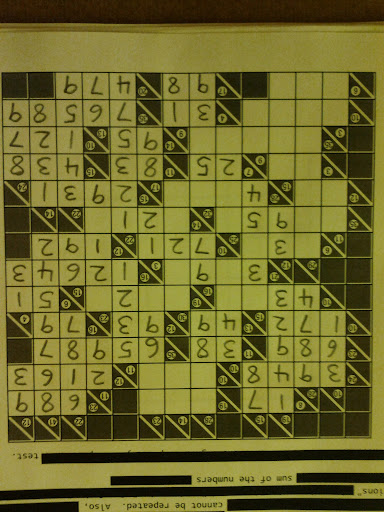
The upper section can be solved by a bottleneck (aka "divide and conquer") technique, and some pair exclusion can solve the lower-left section, leading to:
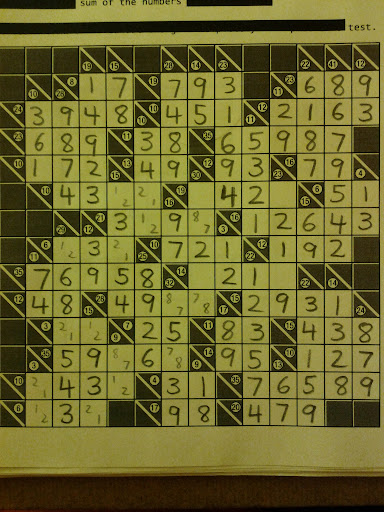
At this point we hit the impossibility. The middle group has two open cells, which can't be 8 or 7 but need to add up to 13 -- but the top one can't be a 9 or a 4.
BATSHIT - Ken-ken
It's a bit easier if we make this look like a traditional Ken-Ken:
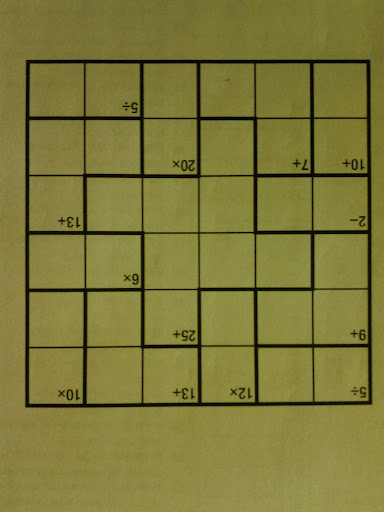
The product and quotient box allow for us to place some of the 5s easily:
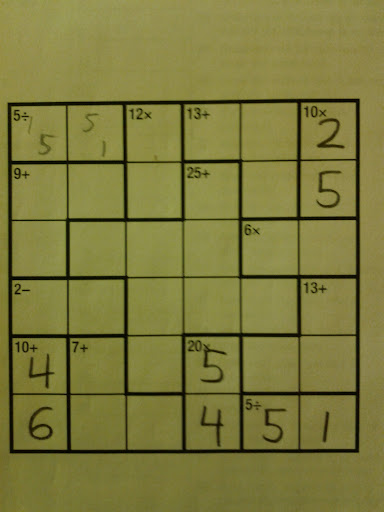
The "7+" box at the bottom can then be determined:
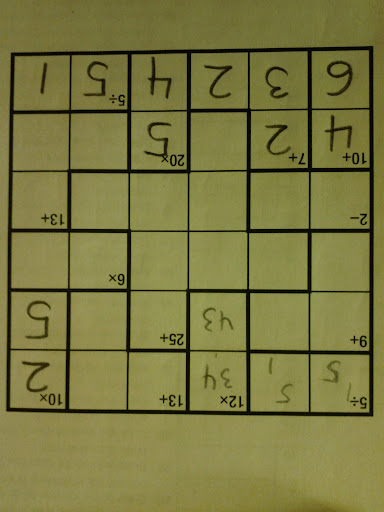
Now look at the 5th row. The 3rd cell can't be 3, so the 3 must be in the "13+" group. So we can't put the 1 in that group as then the other number in that group would be 9. So:
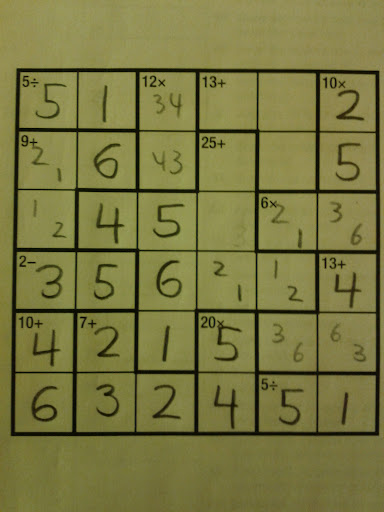
We now have a problem -- the last two cells in the "25+" group need to add up to 6, but one of them is either a 3 or a 6.
X-Com - Minesweeper
Using normal Minesweeper techniques, we end up finding a long alternating chain of 12 cells, where the mines must be alternating on and off in each link of the chain:
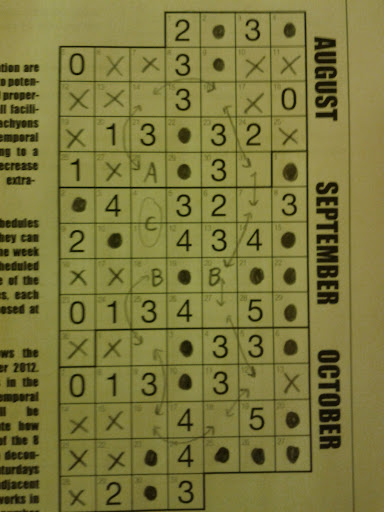
In other words, either cell A is filled and both cell Bs are black, or both cell Bs are filled and cell A is blank. Both choices cause problems with the number of mines in the two cells marked C.
GEE - Nonogram
Most of the Nonogram can be solved normally until you get to a 6x6 area near the center:
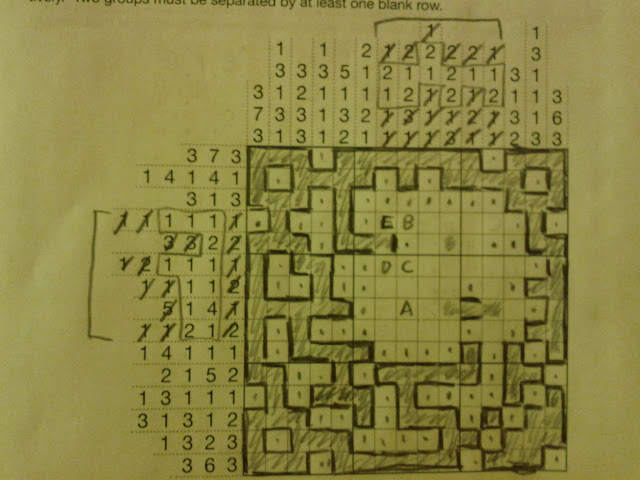
Here things get tricky. One path out is to realize that A can't be empty, because it would force B and C to be filled, which force D and E to be empty, and then we have a problem in the column with D and E. So A is filled, which leads to:
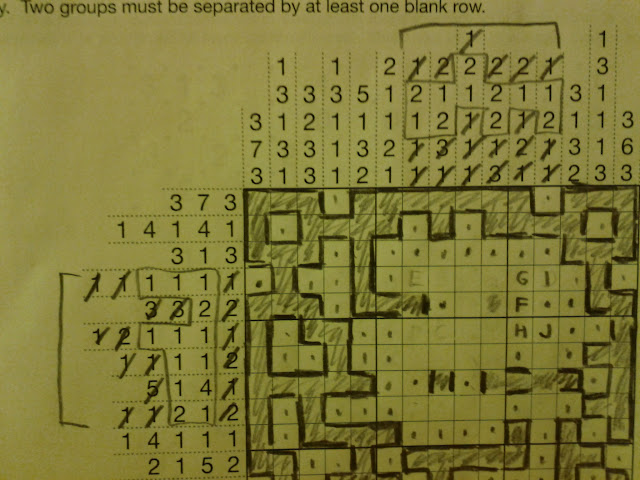
Now F can't be filled without causing a similar issue in GHIJ, so we make that blank:
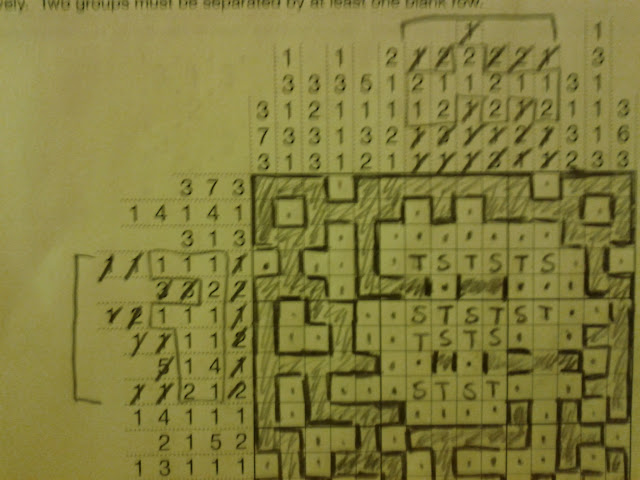
This creates a weird checkerboard situation -- either all the cells marked S are filled, or all the cells marked T are filled. In either case, we have a problem in the bottom row.
UMMM - Slitherlink
Standard Slitherlink techniques get you pretty far:

At this point, the center pattern is rather funky. There are six ways to satisfy all the 2s, but all the ways leave two loops. One way to convince yourself of this is to look at any point on the octagon and convince yourself that it has to connect to another point on the octagon next to it, since it can't cross over without closing the loop prematurely.
Budget
Credits
- Allen: concept, prototype
- Wei-Hwa: revision, development
Manager
Wei-Hwa
Hints
This is a tricky puzzle to hint well. The intended discovery path is:
- Teams notice that the forms are representations of puzzle types they've seen before
- Teams work on the puzzle types, possibly also discovering the form code that confirms that these are indeed types they know about or can search on
- Teams work on the puzzles enough to convince themselves that the puzzles are impossible
- Teams get the "Aha" that Chronos couldn't possibly have any control over the puzzles (and that government is evil), and that if there's any message there must be something in her writing.
- Teams decode the writing and get the message.
The biggest barrier is the third step, which is teams convincing themselves that the puzzles are impossible. It is very easy for a team, when faced with an impossibility, to convince themselves that they made a mistake and that the puzzle is working.
Do not (except in extreme circumstances) confirm with teams that a puzzle is impossible. It's fine if teams get the "Aha" on their own, but you flat-out tell them that a puzzle is impossible, you've deprived them of that "aha". However, to decrease frustration, it's important to guide them towards discovering that on their own as much as possible.
Therefore, for a team that appears to be struggling, play the role of a lab assistant who is trying to also help them with the forms, but also doesn't realize that the puzzle is impossible. Guide them through solving the puzzle and be thorough (as per the notes above), letting them convince themselves that the puzzle is impossible.
Only then should you guide them towards the next step by saying something like "Gosh, maybe the forms are impossible to fill out. I wonder if Professor Chronos realized that and maybe that's why they aren't filled out?"
Response to Correct Answer
Once a team figures it out they should approach the GC member playing the inspector and attempt to bribe him/her. That actor is free to negotiate and ham it up as much as he/she likes.
Then they should be directed back to a lab assistant, who will continue on as noted in 2.04 Mentometer Repair A.